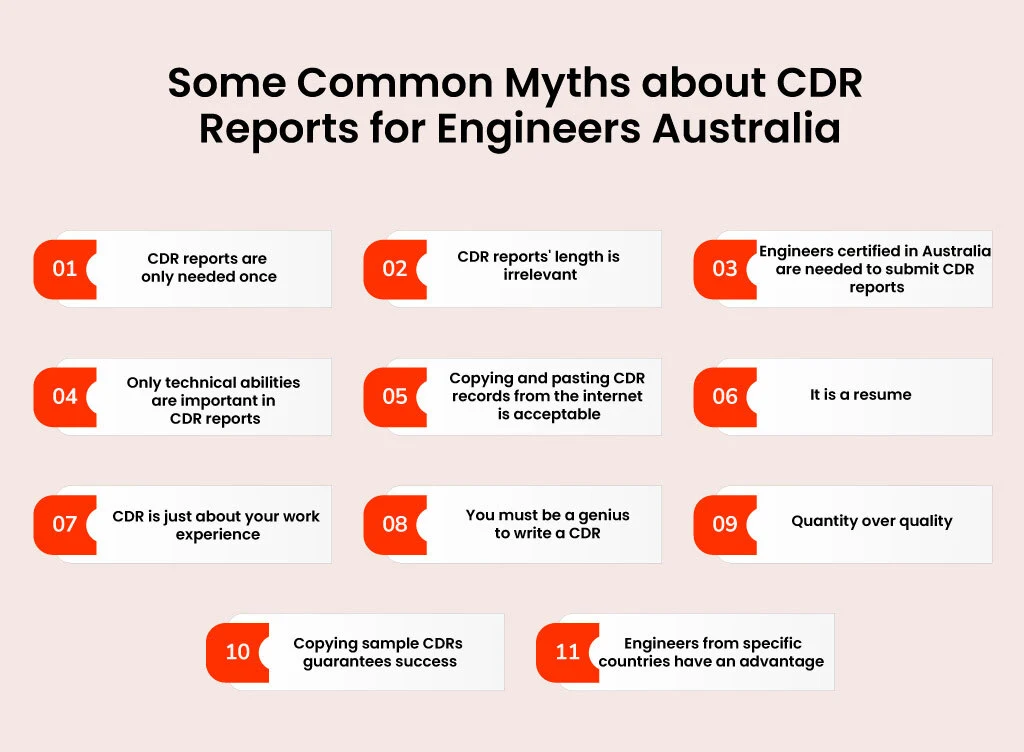Common Myths about CDR Reports for Engineers Australia

Common Myths about CDR Reports for Engineers Australia
Many engineers preparing CDR reports for Australian migration need help understanding the exact requirements and formatting. This can lead to common misconceptions that might hurt their chances of securing a skilled migration visa.
They must grasp the process to ensure their report accurately showcases their skills and competencies. As an engineer aspiring to migrate to Australia, understanding the CDR process is crucial. However, misconceptions often cloud the path, leading to confusion and frustration.
Some Common Myths about CDR Reports about Engineers Australia

In this section, we dive into the myths and misunderstandings often associated with CDR reports. We’ll clear up myths about CDR Reports for Engineers Australia and provide vital information for engineers to craft winning reports demonstrating their capabilities and expertise.
CDR reports are only needed once
Some engineers have myths about CDR Reports for Engineers Australia that they don’t want to bother about CDR reports anymore once they’ve filed their report and obtained their skilled visa.
A fresh CDR report has to be submitted to EA by engineers wishing to apply for an Australian permanent resident visa. The report has to show that, since their last application, the engineer has kept up their skill and competency development.
Similarly, to ensure that their next CDR report submissions are accepted, engineers should remain current on EA’s rules and criteria.
CDR reports’ length is irrelevant
A CDR report’s length is very important. The word count requirements established by the EA should be adhered to by engineers in their reports. Between 1000 and 2500 words must make up the career episodes, and 800 to 1000 words should make up the summary statement.
In addition, EA could only accept lengthy or brief reports. To ensure that their reports are clear and concise, engineers must stick to the requirements established by the Environmental Assessment.
Engineers certified in Australia are needed to submit CDR reports
CDR reports are necessary for all engineers who wish to come to Australia under the skilled migration program, regardless of their qualifications.
Engineers who finished their education outside of Australia must submit a CDR report demonstrating that their credentials and work experience satisfy Australian requirements.
Furthermore, even if an engineer has years of expertise, they must submit a CDR report.
Only technical abilities are important in CDR reports
While technical abilities are important in CDR reports, EA evaluates more than just them. EA also looks for evidence of communication skills, collaboration, problem-solving ability, and leadership traits.
Furthermore, career episodes should highlight a variety of competencies, not just technical ones.
Copying and pasting CDR records from the internet is acceptable
Some engineers attempt to take shortcuts by downloading internet CDR reports and submitting them as their own. This is a serious error that may result in the visa application being rejected immediately. EA utilizes powerful plagiarism detection technologies to detect duplicate text in CDR reports.
Copying someone else’s report constitutes academic dishonesty and is a serious violation. Nonetheless, engineers should build their own legitimate CDR reports to highlight their unique skills and work expertise.
Is it a resume?
Many engineers assume that CDR reports are comparable to resumes and that they may just copy and paste their CVs to generate the report. However, this is not true.
A CDR report is a thorough description of an engineer’s abilities, knowledge, and work experience that must follow a certain format established by Engineer Australia (EA). It needs to include three career episodes that outline the engineer’s work experience and demonstrate their abilities. Furthermore, the report must include a summary statement that connects the capabilities displayed in the career episodes.
CDR is just about your work experience
One of the most prevalent myths about CDRs is that they are merely documentation of your work experience. In reality, CDRs are comprehensive documents that showcase your competencies as an engineer. They include three Career Episodes, a Summary Statement, and a CPD (Continuing Professional Development) list, along with a Curriculum Vitae (CV).
You must be a genius to write a CDR
Another common misconception is that you need to be a genius to prepare a successful CDR. The truth is, that anyone with a solid engineering background and a clear understanding of the guidelines provided by Engineers Australia can write an effective CDR. It’s more about presenting your experiences and skills in a structured and convincing manner.
Quantity over quality
Some applicants believe that including more technical details and using complex jargon will impress the assessors. However, Engineers Australia values quality over quantity. It’s better to focus on significant projects where you made a substantial contribution and explain them rather than inundating the report with irrelevant details.
Copying sample CDRs guarantees success
While sample CDRs can serve as a reference, copying them verbatim is a recipe for disaster. Engineers Australia employs sophisticated plagiarism detection software, and plagiarized CDRs will be rejected outright. Your CDR should reflect your unique experiences, skills, and achievements.
Engineers from specific countries have an advantage
Some applicants believe that engineers from certain countries have an advantage when it comes to CDR assessment. However, Engineers Australia assesses all CDRs based on the same criteria, regardless of the applicant’s nationality. Your CDR will be evaluated solely on its merits.
Conclusion
Debunking these myths is crucial for engineers aiming to migrate to Australia through the CDR pathway. By understanding these common myths, you can approach your CDR with confidence and showcase your engineering capabilities to Engineers Australia. Remember, a well-prepared CDR is your key to unlocking a rewarding engineering career in Australia!
Don’t hesitate to consult Engineers Australia’s official resources or seek guidance from professionals experienced in CDR preparation. You can also contact Report Insider for the perfect CDR report writer, as their team consists of professional CDR writing experts and has positive reviews for their written CDR report. With the right information and preparation, you’ll be well on your way to achieving your engineering dreams in Australia!
FAQ
What is a CDR, and why is it important for engineers aspiring to migrate to Australia?
A Competency Demonstration Report (CDR) is a crucial document required by Engineers Australia for assessing the qualifications and competencies of engineers seeking skilled migration to Australia. It is used to demonstrate that your engineering qualifications and experience meet the standards set by the Australian engineering industry.
How many career episodes do I need to include in my CDR?
You are required to include three career episodes in your CDR. Each career episode should focus on a specific period or aspect of your engineering experience and should highlight your contributions to the projects or tasks undertaken during that time.
Can I include projects from my university studies in my career episodes?
Yes, you can include projects from your university studies in your career episodes, provided they demonstrate your engineering skills and competencies.
How technical should my CDR be?
While your CDR should demonstrate your technical skills, it’s crucial to strike a balance between technical details and broader engineering competencies. Avoid overly technical language and focus on clearly explaining your role, contributions, and the outcomes of your projects.
Can I use CDR writing services to prepare my report?
While CDR writing services can provide valuable assistance with structuring and proofreading your CDR, it’s essential to remember that the content must be authentic and reflect your own experiences and skills. Engaging in such services can be helpful, but the responsibility for the content ultimately lies with you.
How long should my CDR be?
There is no specific word limit for CDRs, but they should be concise and to the point. Aim to provide sufficient information to demonstrate your competencies without including unnecessary details. Generally, a well-prepared CDR is around 3,000 to 4,000 words in total.
Is there a specific format or template for CDRs?
Engineers Australia provides guidelines for preparing CDRs, including the required structure and format. While there is no specific template, following these guidelines is crucial. You can find detailed information about the CDR format on the Engineers Australia website.
How long does it take for Engineers Australia to assess my CDR?
The assessment process typically takes around 12 weeks from the date of submission. However, this timeframe may vary depending on the volume of applications and other factors. You can check the current processing times on the Engineers Australia website.
What are some common CDR mistakes to avoid?
Plagiarism, non-compliance with EA guidelines, technical inaccuracies, incomplete documentation, and poor formatting.
How do you prevent technical inaccuracies in a CDR?
Double-check technical details, consult experts, use relevant standards, and ensure consistency.
What are the consequences of a poorly prepared CDR?
Rejection by Engineers Australia, delays in visa processing, damage to reputation, extra costs, and missed career opportunities.
How do I comply with EA’s formatting requirements?
Follow EA guidelines, use professional templates, pay attention to details, review samples, and ensure compliance before submission.
Why is plagiarism detection important in CDR submissions?
It helps avoid rejection, ensures integrity, uses plagiarism detection tools, references sources properly, and seeks professional assistance if needed.

